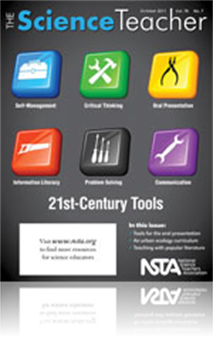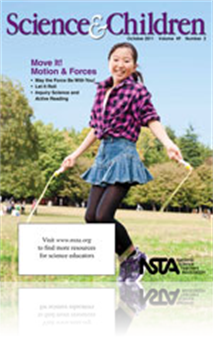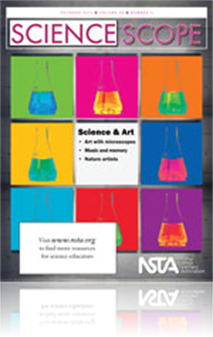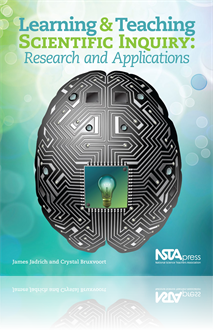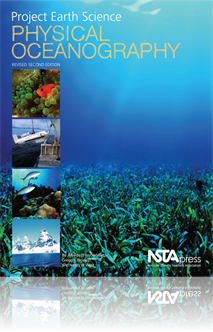All Resources
Journal Article
Science, Technology, and YA Lit
This article provides three engaging projects science teachers can use to help students develop environmental consciousness and global awareness using young adult literature and technology....
Journal Article
The authors used various science investigations to engage preschool and kindergarten-age children with explorations of motion and provided opportunities for them to develop their basic inquiry skills. Using everyday toys and objects is a realistic an...
Journal Article
Enhancing Science Education Through Art
Augmenting science with the arts is a natural combination when one considers that both scientists and artists rely on similar attitudes and values. This article describes simple art activities that allow students to express their science understandin...
Journal Article
Scope on the Skies: Comet Watch
This column focuses on astronomy throughout the year. This month’s issue discusses comets....
Journal Article
The Cultural and Ecological "Worlds" of Central Asia
The authors developed an online, five-week unit that discusses the cultural and ecological "worlds" of central Asia. Two main ideas for this integrated science and social studies unit include (1) The natural world affects the daily functioning of the...
Journal Article
Editor's Note: Skateboarding to Understanding
Science and Children’s editor shares thoughts regarding the current issue....
Journal Article
Environmental Literacy Through Relationships: Connecting Biomes and Society in a Sustainable City
In this article, the authors share a project developed and implemented in an eighth-grade science classroom in which students apply what they have learned about biomes to create sustainable cities. This project promotes environmental literacy through...
Journal Article
This article describes a miniunit that supplements a unit on the study of cells and the use of microscopes, which introduces the fundamentals of cellular biology. The miniunit promoted an inquiry approach to learning and was closely connected to the ...
Journal Article
Secret in the Margins: Rutherford's Gold Foil Experiment
In this article, the authors describe a lesson that uses the 5E Learning Cycle to help students not only understand the atomic model but also how Ernest Rutherford helped develop it. The lesson uses Rutherford's gold foil experiment to focus on three...
Journal Article
Tried and True: The Halloween Lab
This column provides classic demonstrations and experiments with a new twist. In this month’s issue the author describes a Halloween lab that uses physical and chemical changes to teach students about change of state, exothermic reactions, properti...
Journal Article
Students use a portable force indicator to discover the net forces all around them. By directly observing these forces, students can better understand the effect these forces have on an object....
Journal Article
Science 101: Why Don't All Rolling Objects Reach the Bottom of an Incline at the Same Time?
This column provides background science information for elementary teachers. In this month’s issue the author discusses motion and friction....
Journal Article
Everyday Engineering: Charcoal—Can It Corral Chlorine?
This column provides an inside look at the marvels of engineering in everyday life. This issue discusses the use of charcoal in water filters....
Journal Article
Teaching Through Trade Books: A Balancing Act
This column includes activities inspired by children’s literature. In this month’s issue students explore activities that involve balance....
Journal Article
Becoming Science "Experi-mentors"
This article outlines how professional development experiences can best be structured to support teachers' science learning, leading to quality science instruction and learning for students. This discussion highlights four key principles central to e...
Journal Article
Scope on Safety: Trash Talk: How to Compost Safely
This column shares safety information for your classroom. In this month’s issue the author discusses safe composting....
Journal Article
Editor's Roundtable: Art Appreciation
Science Scope’s editor shares thoughts regarding the current issue....
Journal Article
The Green Room: Start an Environmental Club
This column focuses on making your teaching more environmentally friendly. This month’s issue discusses different activities that students can do as part of an environmental club....
Journal Article
Editor's Corner: 21st-Century Skills
The Science Teacher’s editor shares thoughts on the current issue....
Journal Article
Myths, Misconceptions, and Misunderstanding: Polar Misunderstandings: Earth's Dynamic Dynamo
This column identifies and corrects misinformation in the classroom. This month’s issue discusses the movement of Earth's north and south poles....
Journal Article
This article outlines a 30-day nature of science unit designed for first graders, provides journal prompts, and gives examples of students' ideas through their quotes and journal entries. During the lessons, students learn about nature of science ten...
Journal Article
Idea Bank: Getting Up to Speed
The Idea Bank provides tips and techniques for creative teaching, in about 1,000 words. In this month’s Idea Bank, the author discusses the common high school physics activity of calculating walking speed. The author adapted this activity and three...
Journal Article
Art in Motion: A Sailboat Regatta
This activity uses the creative natures of visual art and music to enhance students' potential for creativity while increasing their understanding of the science associated with force and motion. Students design, test, and redesign an sailboat vehicl...
Journal Article
Science in the 21st Century: More Than Just the Facts
The authors have worked to meet the demands of the 21st century by using the Urban EcoLab, an urban ecology curriculum based on the National Science Education Standards. This curriculum emphasizes the local and community-based nature of science and i...
NSTA Press Book
Humans perceive the world by constructing mental models—telling a story, interpreting a map, reading a book. Every way we interact with the world involves mental models, whether creating new ones or building on existing models with the introduction...
By Steven W. Gilbert
eBook
Learning and Teaching Scientific Inquiry: Research and Applications (e-book)
Science teacher educators, curriculum specialists, professional development facilitators, and K–8 teachers are bound to increase their understanding and confidence when teaching inquiry after a careful reading of this definitive volume. Advancing a...
eBook
Models-Based Science Teaching (e-book)
Humans perceive the world by constructing mental models—telling a story, interpreting a map, reading a book. Every way we interact with the world involves mental models, whether creating new ones or building on existing models with the introduction...
Book Chapter
Designing Scientific Tests and Investigations
Designing tests to evaluate scientific models and explanations is one of the hardest—and at the same time one of the most creative—aspects of science. This chapter is devoted to the process of designing tests and investigations to evaluate models...
Book Chapter
Sailors have known for centuries that ocean currents can speed up or slow down a ship. In modern times, scientists have discovered that ocean currents have major effects on climate and weather patterns, and on the ecology of the ocean and nearby land...
Book Chapter
Waves are among the most common phenomena in nature. Waves breaking in the ocean, sound, light, microwaves, radio, or the motion of a guitar cord or a drum are all forms of waves. Such diversity makes finding common properties a challenge but, in ge...
Book Chapter
What are some of the ways you can make waves in water? Have you ever jumped into a pool or lake and done a “cannonball”? This makes waves. The largest water waves on Earth are found in the oceans, and most ocean waves are created by wind. The lar...
Book Chapter
Tanks a Lot—Activities for a Wave Tank (Teacher Demonstration)
Some concepts related to waves, though, are difficult to demonstrate in the classroom. They require observing water waves on a scale that is not ordinarily feasible for the classroom teacher because the necessary equipment is not available. The teach...
Book Chapter
Anyone who has been to the coast realizes there is a rhythm to the ocean. Waves crash onto the beach or rocks. The water they carried washes ashore, then retreats. Another wave crashes ashore. The pattern repeats. However, there is another rhythmic p...
Book Chapter
The Sun, Moon, and Earth are three extremely large objects separated by great distances. Despite the large distances between them, each object affects the others. Earth is kept in orbit around the Sun by the gravitational forces between them. The Moo...
Book Chapter
The Bulge on the Other Side of Earth
The bulge of water on the side of Earth that faces the Moon is easily explained. It is due to the gravitational attraction between the Moon and Earth, including the water on Earth. The difference on the horizontal component of gravity results in wat...



